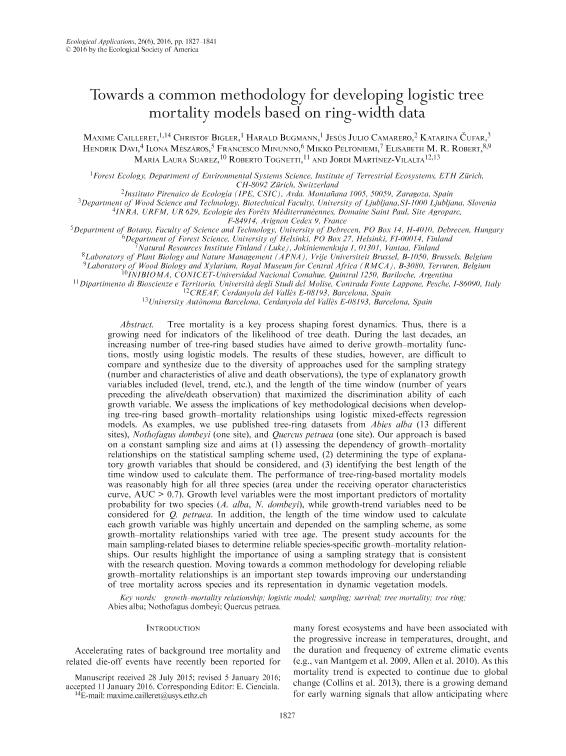Artículo
Towards a common methodology for developing logistic tree mortality models based on ring-width data
Cailleret, Maxime; Bigler, Christof; Bugmann, Harald; Camarero, Jesús; Čufar, Katarina; Davi, Hendrik; Mészáros, Ilona; Minunno, Francesco; Peltoniemi, Mikko; Robert, Elizabeth; Suarez, Maria Laura ; Tognetti, Roberto; Martínez Vilalta, Jordi
; Tognetti, Roberto; Martínez Vilalta, Jordi
 ; Tognetti, Roberto; Martínez Vilalta, Jordi
; Tognetti, Roberto; Martínez Vilalta, Jordi
Fecha de publicación:
09/2016
Editorial:
Ecological Society of America
Revista:
Ecological Applications
ISSN:
1051-0761
e-ISSN:
1939-5582
Idioma:
Inglés
Tipo de recurso:
Artículo publicado
Clasificación temática:
Resumen
Tree mortality is a key process shaping forest dynamics. Thus, there is a growing need for indicators of the likelihood of tree death. During the last decades, an increasing number of tree-ring based studies have aimed to derive growth–mortality functions, mostly using logistic models. The results of these studies, however, are difficult to compare and synthesize due to the diversity of approaches used for the sampling strategy (number and characteristics of alive and death observations), the type of explanatory growth variables included (level, trend, etc.), and the length of the time window (number of years preceding the alive/death observation) that maximized the discrimination ability of each growth variable. We assess the implications of key methodological decisions when developing tree-ring based growth–mortality relationships using logistic mixed-effects regression models. As examples, we use published tree-ring datasets from Abies alba (13 different sites), Nothofagus dombeyi (one site), and Quercus petraea (one site). Our approach is based on a constant sampling size and aims at (1) assessing the dependency of growth–mortality relationships on the statistical sampling scheme used, (2) determining the type of explanatory growth variables that should be considered, and (3) identifying the best length of the time window used to calculate them. The performance of tree-ring-based mortality models was reasonably high for all three species (area under the receiving operator characteristics curve, AUC > 0.7). Growth level variables were the most important predictors of mortality probability for two species (A. alba, N. dombeyi), while growth-trend variables need to be considered for Q. petraea. In addition, the length of the time window used to calculate each growth variable was highly uncertain and depended on the sampling scheme, as some growth–mortality relationships varied with tree age. The present study accounts for the main sampling-related biases to determine reliable species-specific growth–mortality relationships. Our results highlight the importance of using a sampling strategy that is consistent with the research question. Moving towards a common methodology for developing reliable growth–mortality relationships is an important step towards improving our understanding of tree mortality across species and its representation in dynamic vegetation models
Palabras clave:
TREE MORTALITY
,
GROWTH
,
LOGISTIC MODEL
,
TREE RING
,
SAMPLING
,
SURVIVAL
Archivos asociados
Licencia
Identificadores
Colecciones
Articulos(INIBIOMA)
Articulos de INST. DE INVEST.EN BIODIVERSIDAD Y MEDIOAMBIENTE
Articulos de INST. DE INVEST.EN BIODIVERSIDAD Y MEDIOAMBIENTE
Citación
Cailleret, Maxime; Bigler, Christof; Bugmann, Harald; Camarero, Jesús; Čufar, Katarina; et al.; Towards a common methodology for developing logistic tree mortality models based on ring-width data; Ecological Society of America; Ecological Applications; 26; 6; 9-2016; 1827-1841
Compartir
Altmétricas



